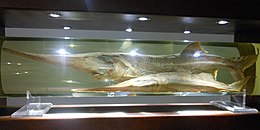Chinese paddlefish
| Chinese paddlefish | |
|---|---|

| |
| Preserved specimens at Museum of Hydrobiological Sciences, Institute of Hydrobiology, Wuhan, China | |
| Scientific classification | |
| Domain: | Eukaryota |
| Kingdom: | Animalia |
| Phylum: | Chordata |
| Class: | Actinopterygii |
| Order: | Acipenseriformes |
| Family: | Polyodontidae |
| Genus: | †Psephurus Günther , 1873
|
| Species: | †P. gladius
|
| Binomial name | |
| †Psephurus gladius (von Martens, 1862)
| |
| Synonyms[2][3] | |
| |
The Chinese paddlefish (Psephurus gladius;
The Chinese paddlefish was officially declared extinct in 2022, with an estimated time of extinction to be by 2005, and no later than 2010, although it had become
Description
The Chinese paddlefish had a white underbelly, and its back and head were grey.
Juveniles attained a weight of around 1 to 1.5 kilograms (2 to 3 lb) by their first winter and a length of 1 m (3 ft) and a weight of about 3.3 kg (7 lb 4 oz) by the time they were a year old. Beyond this length, proportional weight gain relative to body length dramatically increased, reaching a weight of about 12.5 kg (28 lb) by the time they were around 1.5 m (5 ft) long. They reached sexual maturity at a weight of around 25 kg (55 lb).[11] The maximum length of the Chinese paddlefish is often quoted as 7 m (23 ft), with this estimate apparently being given by C. Ping (1931), though according to Grande and Bemis (1991), specimens over three metres (ten feet) had not been definitively measured.[9] Ping recorded that fishermen in Nanjing caught a Chinese paddlefish with a length of 7 metres (23 ft) and a weight of 907 kilograms (2,000 lb).[12] FishBase and World Wide Fund for Nature gives a conservative maximum weight of 300–500 kg (660–1,100 lb).[13][14] Female fish are suggested to have grown larger than male fish once sexually mature, though they grew at similar rates prior to this.[15] The lifespan has been estimated at 29–38 years, though the theoretical maximum lifespan is likely to have been significantly higher, as the estimate reflects anthropogenic impacts on the population.[4]
Taxonomy and evolutionary history

The species was first named as a species of
Relationships of recent and fossil paddlefish genera, after Grande et al. (2002).[19]
| ||||||||||||||||||||||||||||
Distribution, habitat and ecology
The Chinese paddlefish was native to the
The species spent part of its life in the lower section of the Yangtze, including the

The fish was largely solitary, and occupied the lower-mid layers of the
Decline and extinction
The last records of Chinese paddlefish in the Yellow River basin and its estuary date back to the 1960s, although declines were realized between the 13th and 19th centuries.[24][25][30] Declines were significant throughout its primary range in the Yangtze basin, but annual captures of 25 tonnes continued into the 1970s.[4] In 1983, the Chinese government made fishing of the species illegal due to its decline in numbers.[26] The species was still being found in small numbers in the 1980s (for example, 32 were caught in 1985), and young were seen as recently as 1995.[1] Due to the rarity of the fish by the time it was realised that it was in peril, and the fact that the adult fish were difficult to keep in captivity, attempts to create a captive breeding stock failed.[26]

Since 2000, there have been only two confirmed sightings of the fish alive, both from the Yangtze basin: The first was a 3.3-metre (10 ft 10 in), 117-kilogram (258 lb) female caught at Nanjing in 2002 and the second a 3.52-metre (11 ft 7 in), 160 kg (350 lb) female accidentally caught at Yibin, Sichuan, on January 24, 2003, by fisherman Liu Longhua (刘龙华);[31] the former died despite attempts to save it and the latter was radio-tagged and released, but the tag stopped working after only 12 hours.[1][32]
During a search conducted in the Yangtze basin from 2006 to 2008, a research team from the
The official IUCN status of the species was formally updated to "extinct" in July 2022.[6][1]
See also
- Baiji, a species of river dolphin also native to the Yangtze, which became extinct around the same time as the Chinese paddlefish and due to the same factors
- List of endangered and protected species of China
References
- ^ . Retrieved 21 July 2022.
- ^ Froese, R.; Pauly, D. (2017). "Polydontidae". FishBase version (02/2017). Archived from the original on 24 August 2017. Retrieved 18 May 2017.
- ^ "Polydontidae" (PDF). Deeplyfish- fishes of the world. Archived (PDF) from the original on 24 August 2017. Retrieved 18 May 2017.
- ^ S2CID 210086307.
- ^ a b "The Chinese paddlefish was reevaluated to be extinct". IUCN. September 2019. Archived from the original on 23 August 2020.
- ^ a b Master, Farah; Zhang, Albee (22 July 2022). Fullick, Neil (ed.). "Chinese Paddlefish and wild Yangtze Sturgeon extinct - IUCN". Reuters. Archived from the original on 23 July 2022. Retrieved 22 July 2022.
- ^ S2CID 38833459.
- ^ a b c d e f "Species Fact Sheets: Psephurus gladius (Martens, 1862)". Food and Agricultural Organization of the United Nations. Archived from the original on 3 October 2009. Retrieved 1 February 2019.
{{cite web}}: CS1 maint: unfit URL (link) - ^ ISSN 0272-4634.
- ISBN 978-1-4020-2832-8, archivedfrom the original on 25 July 2022, retrieved 22 July 2022
- ^ JSTOR 1445891.
- ^ Contributions from the Biological Laboratory of the Science Society of China: Zoological series. Vol. 7. 1931. p. 189.
- ^ Froese, Rainer; Pauly, Daniel (eds.) (2010). "Psephurus gladius" in FishBase. July 2010 version.
- ^ "River of Giants: Giant Fish of the Mekong" (PDF). WWF for Nature. 2012.
- ^ J. Ma, Z. Deng, X. Deng, M. Cai Age determination and growth of Chinese paddlefish Psephurus gladius Acta Hydrobiologica Sinica, 20 (2) (1996), pp. 150–159 (in Chinese with English abstract)
- ^ "Über einen neuen Polyodon aus dem Yantsekiang und über die sogenannten Glaspolypen". Monatsberichte der Königlichen Preussischen Akademie der Wissenschaften zu Berlin. 1861 (pt. 1): 476–479. 2 May 1861. Retrieved 29 July 2022.
- .
- ^ Kaup, J.J. (1862). "Eine neue Art von Spatularia". Archiv für Naturgeschichte. 28 (1): 278–281.
- ^ from the original on 16 July 2022. Retrieved 22 July 2022.
- S2CID 222213273.
- from the original on 30 June 2022. Retrieved 22 July 2022.
- S2CID 250059162.
- S2CID 211555175.
- ^ PMID 29721289.
- ^ ISBN 9789578596771.
- ^ ISBN 0-7923-4517-7, archivedfrom the original on 25 July 2022, retrieved 24 July 2022
- ISSN 2330-8249.
- ISBN 978-0-7923-4517-6. Retrieved 27 July 2022.
Living sturgeons and primitive paddlefishes (i.e.,polyodontids other than Polyodon) stand in sharpcontrast to all of these outgroup taxa. Their jaws are highly mobile, so that the upper jaw can be 'projected' far out to capture prey...
- S2CID 73442571.
- ^ S2CID 210086307.
- ^ "最后的长江白鲟"目击者:3.52米长 160公斤重 消失在宜宾江水中……-新华网. xinhuanet.com. Archived from the original on 7 January 2020. Retrieved 9 January 2020.
- ^ a b Bourton, Jody (29 September 2009). "Giant fish 'verges on extinction'". BBC News. London: BBC. Archived from the original on 31 May 2012. Retrieved 29 September 2009.
- ^ Zhang; Wei1, Q.W.; Du, H.; Shen, L.; Li, Y.H.; and Zhao, Y. (2009). Is there evidence that the Chinese paddlefish (Psephurus gladius) still survives in the upper Yangtze River? Concerns inferred from hydroacoustic and capture surveys, 2006–2008. Journal of Applied Ichthyology 25(s2): 95-99. DOI: 10.1111/j.1439-0426.2009.01268.x.
- ^ Yirka, Bob (8 January 2020). "Chinese paddlefish declared extinct". Phys.org. Archived from the original on 8 January 2020. Retrieved 9 January 2020.
- ^ Cheung, Eric (7 January 2020). "Up to 23 feet long, the Chinese paddlefish was the giant of the Yangtze. And we killed it". CNN. Archived from the original on 9 January 2020. Retrieved 9 January 2020.
- ^ "Chinese paddlefish, one of world's largest fish, declared extinct". Animals. 8 January 2020. Archived from the original on 8 January 2020. Retrieved 9 January 2020.

